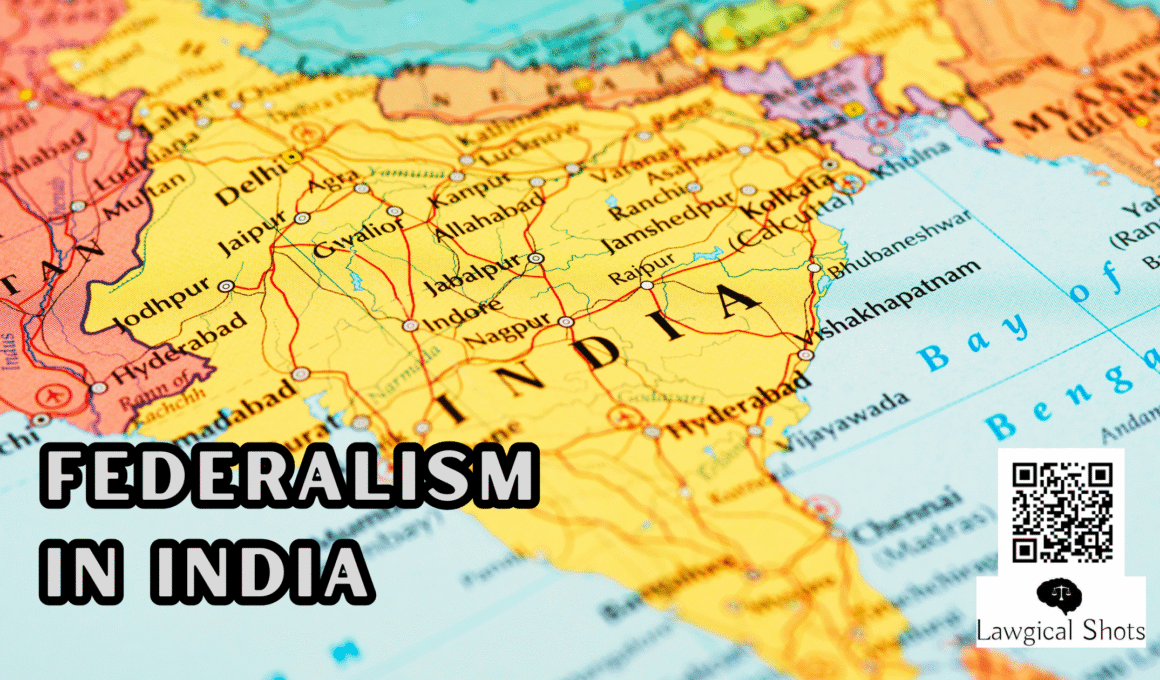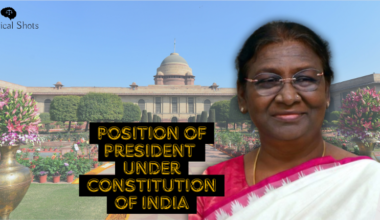“Federalism is not about states’ rights. It’s about dividing power to better protect individual liberty.”
~ Elizabeth Price Foley
What is Federalism in India?
Federalism is a form of government where power is shared between the Central and regional authorities, such as states or provinces. The Indian Constitution sets up a federal system but also includes some features of a unitary system. Because of this combination, it is often called a quasi-federal system. It means that India has elements of both a federation and a union. In India, the Constitution divides responsibilities between the Central and State governments. It is further strengthened by a third level of government known as local self-government.
Federalism in India helps maintain unity among diverse cultures and communities. Generally, federal systems are found in countries that are culturally varied or spread over a large area. Some well-known examples of federal countries or those with similar features include the United States, Brazil, Canada, Germany, and India.
Federations can be classified into two main types:
- Holding-together federation
In this type, a single sovereign country decides how power is shared between the central government and the states. The central government usually has more authority than the states. Examples include India, Spain, and Belgium.
- Coming together federation
Here, separate states unite to form a larger federal unit. In this case, power is distributed equally among all states, and the central government does not interfere. Examples are the United States, Australia, and Switzerland.
Development of Federalism in India Over the Years
Before India secured independence, federalism had its roots in the Simon Commission Report of 1930, which first suggested the idea of a federal system. This idea was supported further at the First Round Table Conference in 1930, and the British government eventually agreed to create an All-India Federation that would include both British India and the Princely States.
The Government of India Act 1935 laid out these federal ideas and influenced the future Constitution. However, the actual federal setup was never put into place, and only provincial autonomy was implemented in 1937. The 1946 Constituent Assembly supported federalism, and initially, it aimed for strong provincial governments and a weaker central authority, as proposed by Pandit Nehru’s Resolution. There was a lot of discussion over Federal or Unitary authority, as reflected in the Constituent Assembly Debates.
This plan changed when the Union Powers Committee suggested that the Central Government should have control over all matters not specifically given to the states. As a result, when India became independent in 1947, it was more of a centralized, unitary state, where the central government held most of the power, and the states had limited autonomy. The fact shaped the federal structure that exists in India today.
Federalism In Post-Independent India
India’s federal system has changed over time, dealing with growing regional and language based politics that created new states and strong local parties. In the 1960s and 1970s, the Central Government comparatively held more control, especially during the National Emergency and when the President governed instead of State governments. The 1980s and 1990s brought more focus on giving States more power through Constitutional changes, but disagreements over money and resources kept tensions high.
The way money is shared and used between the Center and States has always been a hiccup. The recent COVID-19 pandemic reflected upon the need for tuning between Central and State governments for smoother governance.
Federal Features of Indian Constitution
The Indian Constitution has certain features that show how power is shared between the Central government and the States, while also keeping the country united and diverse. It creates a strong central authority along with regional autonomy. Here are the main features of the federal structure in the Indian Constitution:
- Dual Government System
The Indian Constitution sets up a dual system of government, where the Central government is at the top and the State governments are at the periphery. Each level of government has its own area of authority, as decided by the Constitution. This ensures that both the center and the states can independently carry out their roles without overlapping.
- Division of Powers Between the Center and States
One of the key aspects of federalism is how power is divided between the central and state governments. In India, the central government handles matters that affect the whole nation, where a uniform policy is needed for the benefit of all. On the other hand, the states take care of issues that are more local in nature. This division ensures that both levels of government stay within their own areas, without overstepping into each other’s responsibilities.
– The Indian Constitution’s Articles 245 to 254 define the legislative powers of the central and state governments.
– The Seventh Schedule of the Constitution lists three categories of subjects that are divided between the center and the states (Article 246).
– In case of a conflict on the concurrent list, the laws passed by Parliament take precedence (Article 254). - Written Constitution
A federal government usually has a written constitution.
The Indian Constitution is a written document, consisting of 448 articles and 12 schedules. It is one of the most detailed and comprehensive Constitutions in the world. - Supremacy of the Constitution
In a federal system, the Constitution is the highest authority for both the Central government and the individual States. It stands above all other laws and rules. - Rigidity of the Constitution
Since the Indian Constitution is written, it also has a rigid structure. This means that changing the Constitution requires a complex process. However, it doesn’t mean the Constitution is completely unchangeable. Some parts of the Constitution can be amended with a simple majority, while others require a special procedure (Article 368). Examples include:
– Amending the Constitution in a way that does not affect the federal structure.
– Removing judges from the Supreme Court or High Courts.
– Approving a national emergency. - Independent and Integrated Judiciary
For a federal state, it is important that the judiciary is both independent and impartial. An independent judiciary means that the Courts are free from control by the legislative and executive branches of the government. On the other hand, an integrated judiciary means that decisions made by higher courts must be followed by lower courts.
The Supreme Court is the highest court in the country’s judicial system. Below it, there are High Courts, which operate at the State levels and have authority over subordinate courts. This single system of courts handles both the central (federal) laws and the laws made by the states. This is different from the United States, where the federal courts deal with federal laws, and state courts handle state laws.
- Bicameralism
A bicameral system is important in a federation. The Indian Constitution provides for a bicameral legislature at the Central level, consisting of the Lok Sabha and the Rajya Sabha. The Lok Sabha, or lower house, is made up of elected members representing the people. The Rajya Sabha, or upper house, consists mainly of members elected by the State Legislative Assemblies. Some States in India also follow bicameralism.
Federal Provisions in Indian Constitution
The Indian Constitution establishes a dual polity (Article 1 read with Part V and Part VI) and outlines the division of powers between the Central and State governments (Article 246 read with the 7th Schedule). During normal times, the States have the same level of authority over the State list as the Union has over the Union List. Part VI of the Indian Constitution provides for the independent constitutional existence of the States within the Indian Union.
- Article 1- India, that is Bharat, shall be a union of states.
- Article 7 – Parliament is made up of two houses: the Lok Sabha and the Rajya Sabha.The Rajya Sabha serves as a representative body for the states in the Indian federal system.
- Article 131 – The Supreme Court of India is independent and is the only court that settles disputes between the central government and the states.
- Article 246 – This article outlines how legislative subjects are divided between the Union and the State governments, with subjects listed in the Union List, the State List, and the Concurrent List.
- Article 368 – This article describes two types of amendment processes, making the Constitution of India a unique blend of rigidity and flexibility.
It also allows for the amendment of federal provisions with the approval of at least half of the state legislatures
Ways for strengthening Federalism in India
- Enhancing the sharing of power and resources: To make federalism stronger, there should be more transfer of powers and resources from the central government to the states and local bodies. This can be done by revising the list of subjects that the central and state governments can handle, increasing the share of tax revenue that goes to the states, and giving them more control over their finances and decision-making.
- Ensuring better participation and representation: To strengthen federalism, states should have a bigger role in national decisions. This means including them in the making and execution of national policies and programs. They should have more say in federal institutions like the GST Council, the Inter-State Council, and the NITI Aayog.
- Encouraging cooperation and healthy competition: Federalism can be made stronger by encouraging states to work together on common issues and challenges. They should learn from each other’s best practices and innovations. Incentives should be given to states that perform well and achieve good results.
- Addressing regional imbalances and inequalities: Federalism can be improved by tackling regional imbalances and inequalities. This can be done by providing special support and resources to backward and marginalized regions. There should be fair and equal distribution of resources and opportunities across different regions. Setting up regional development councils might also help.
Judicial Take on Federalism
The Indian judiciary has dealt with several cases that touch upon the federal nature of the country.
1. State of West Bengal v. Union of India (1964): The Supreme Court said that the Indian Constitution is not truly federal but has a “federal structure with a unitary bias.” This means that although India has a federal system with power shared between the central and state governments, the constitution gives more power to the central government, particularly in economic and industrial matters. The states are mainly responsible for local issues. This shows that the power distribution is not balanced and leans in favor of the center.
2. Kesavananda Bharti v. State of Kerala (1973): The Supreme Court ruled that federalism is a fundamental feature of the Indian Constitution. This means that the structure of the Constitution is based on the principles of federalism, which involves the division of powers between the central and state governments. This case is considered a landmark decision that highlights the importance of federalism in the Indian Constitution.
3. S.R. Bommai v. Union of India (1994): In this case, the Supreme Court stated that although power is more concentrated in the center than in the states, and it is referred to as a “quasi-federal” system, the real issue is how the provisions are applied during a presidential emergency under Article 356.
Significance of Indian Federalism
Indian federalism is important because it helps maintain unity while respecting regional diversity. It allows for cooperative governance and balanced development across the country.
The significance of Indian federalism can be understood through the following points:
– Accommodation of diversity: Federalism allows states to govern themselves and address their specific needs and concerns.
– Effective governance: A strong federal system ensures that the diverse needs and interests of different regions are considered in the decision-making process.
– Promotion of democracy: Federalism promotes democracy by distributing power among different levels of government.
This allows citizens to have a greater say and be more involved in the decision-making process.
– Protection of rights: Federalism helps protect individual and minority rights as state governments can better address the specific needs of their populations and create policies that suit their needs.
Conclusion
Federalism in India is seen as a way to empower people and build a united nation.
It has been successful in creating a federal union. Over time, Indian federalism has shown enough strength to adapt to the different challenges of forming a federal state. The Sarkaria Commission Report is viewed as an effort to ensure that the federal system in India functions well and remains strong.
The various facets of Federalism in India has been elaborated by our intern, Ms Manya Mishra. She has been assisting the team in bringing informational legal blogs.







